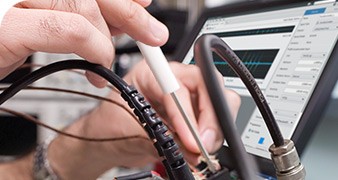Modular Instruments Courses
Learning paths for installing, setting up and controlling NI PXI Modular Instruments
These on-demand courses are for engineers using NI PXI modular instruments to create, generate, acquire, and analyze data and signals, both interactively in InstrumentStudio™ software and programmatically in LabVIEW. Learn the complete test workflow from configuration and cabling to control, calibration, debugging, and optimizing for speed and precision.
New user learning path
This path is for new users working with a PXI hardware system who need to set up, maintain, and synchronize tasks across PXI hardware systems.
PXI Platform Course
| Description | Recommended Prerequisites |
| Explore the components of PXI systems and learn how to connect, set up, troubleshoot, and maintain the hardware safely | ||
| PXI Timing and Synchronization | Explore the fundamentals of synchronization and the NI software and hardware tools available to implement synchronization methods. | PXI System Setup and Maintenance |
Software Courses
| Description | Recommended Prerequisites |
| Creating Measurement Plug-Ins for InstrumentStudio | Create and deploy Measurement Plugins using a template in Python and/or LabVIEW and use the measurements in InstrumentStudio and TestStand. | |
| Introduction to InstrumentStudio | Explore the main features available in InstrumentStudio and InstrumentStudio Professional Edition. | |
| LabVIEW Core 1 | Explore the LabVIEW environment, dataflow programming, and common LabVIEW development techniques in a hands-on format. | |
| LabVIEW Core 2 | Design, implement, and distribute stand-alone applications using LabVIEW and apply single- and multiple-loop design patterns for application functionality. | LabVIEW Core 1 |
Experienced user learning path
This path is for Production Test and Validation Engineers or System Integrators who need to measure or generate signals with NI Modular Instruments.
Course Name | Description | Recommended Prerequisites |
Select, set up, maintain and troubleshoot switches in your system. |
| |
Select and set up a DMM device and perform both interactive and programmatic measurements of a DUT. |
| |
Source and measure voltage and current in order to perform common device tasks and tests, such as power-up and I-V characterization. |
| |
Take inductance, capacitance, and resistance measures with NIs LCR Meter, such as single-point measurements, C-V sweeps, and frequency sweeps. |
| |
Select and set up an oscilloscope device and perform both interactive and programmatic measurements of their DUT. |
| |
Select and set up a waveform generator device and perform both interactive and programmatic outputs to their DUT. |
| |
Leverage digital pattern instruments and the Digital Pattern Editor to perform common device tests, with a focus on DUT communication, digital interface testing, and continuity and leakage testing. |
|
| RF Courses | Description | Recommended Prerequisites |
Introduction to RF Signal Generation Acquisition and Analysis with NI RF Technologies | Introduction to creating, generating, acquiring and analyzing RF signals with the NI-RFmx driver and Soft Front Panels, NI-RFmx Waveform Creator and the NI-RFSG driver. | |
Measuring Power-Added Efficiency with Pulsed RF Measurement Library | Use NI’s Pulsed RF Measurement Library to set up for Power Added Efficiency (PAE) measurements and take the measurements using the UI and programmatically. | |
Learn the features and common workflow of the NI RFmx Platform for Generation and Analysis. |
Additional Course Options
Acoustic Test Fundamentals
Learn about the standard methodologies, measurements, and requirements for acoustic test; acoustic data processing methods; and the hardware components of a test station.
Introduction to NI Audio and Acoustics Test Software
Use the NI Audio and Acoustics Test Software to run tests and perform speaker measurements and PDM microphone measurements.
SLSC Fundamentals
Set up and use NI and NI Partner Switch Load and Signal Conditioning (SLSC) hardware in order to standardize connectivity for Hardware in the Loop tests of increasingly complex systems.
Upgrade to Membership
Planning to take three or more NI instructor-led courses within one year?
A Training Membership provides cost-effective, unlimited access to all NI public classroom and public virtual courses, along with unlimited certification vouchers.


